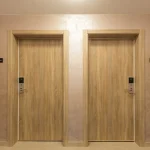Short answer: Measuring your space properly before you order a sofa can save you a lot of headaches – and ensure your new couch looks great, fits perfectly, and makes your living room feel open and inviting.
Why It Pays to Measure Twice
Buying a sofa is one of the biggest furniture decisions you’ll make for your home. Get it wrong, and you could end up with a piece that blocks doorways, overwhelms your space, or (worst case) doesn’t even make it through your front door.
The good news? A few simple measuring steps take the guesswork out of sofa shopping and help you invest wisely the first time.
1. Measure Your Room First
Grab a tape measure and jot down your room’s length and width. Note anything that could impact placement: doorways, windows, radiators, built-ins, or even where your TV sits. It helps to draw a quick floor plan, so you can see the big picture.
2. Define the Perfect Footprint
Use painter’s tape to mark your sofa’s outline directly on the floor. If you want to get fancy, cut out cardboard or craft paper to match your sofa’s dimensions and move it around until it feels right.
This trick is a lifesaver for visualizing flow – does the sofa block pathways? Will you still have space for side tables and rugs? Seeing it mapped out helps you avoid surprises.
3. Don’t Forget the Doorways
Many people nail the floor plan but forget to measure the path the sofa will travel. Always check door frames, hallways, stairwells, and elevators. Measure height, width, and diagonal clearance if you’ll need to angle the piece.
Tip: Detachable legs or modular designs can help if you’re working with tight spaces.
4. Mind the Scale & Room Flow
A sofa that’s too big can make your living area feel cramped. Too small, and it’ll look lost in a large space. Aim to leave at least 18 inches between the sofa and a coffee table and 30–36 inches for pathways. This keeps the layout open, comfortable, and functional.
Consider balance as well – if you have a chunky sectional, try pairing it with lighter chairs and tables to prevent the room from feeling weighed down.
5. Pay Attention to Seat Depth
Seat depth affects how your sofa feels and fits. Deep seats are cozy for lounging but can eat up valuable floor space – and may not be comfortable for shorter people or formal sitting areas.
Sit on sofas in stores if you can, and compare depths. Knowing your sweet spot helps you choose a sofa that feels good day after day.
6. Check for Special Features
If you’re considering a sleeper sofa, chaise lounge, or reclining sectional, measure how much space these features need when fully extended. It’s easy to overlook how far a pull-out bed sticks out into your living room until it’s too late.
Bonus: When Custom Makes Sense
Sometimes, no standard size works quite right – maybe you have an awkward alcove, loft corner, or unique layout. In cases like this, a custom or modular sofa can be a game-changer.
Brands like DreamSofa specialize in made-to-order sectionals and couches, letting you tweak dimensions down to the inch so you don’t have to settle for “almost right.”
Mock It Up, Live With It
If you’re on the fence, try living with your tape outline or cardboard cutout for a day or two. Walk around it, imagine movie night or guests, and see how it feels to navigate the space. Small tweaks now can save you big regrets later.
Final Thoughts
A sofa is more than just a big piece of furniture – it’s where you relax, work, nap, and gather with friends and family. Taking a few extra minutes to measure properly will help you avoid awkward layouts, tricky returns, and costly mistakes.
So grab your tape measure, check your pathways, and mark your space before you click “buy.” Your future self (and your back) will thank you.
FAQs
- What tools do I need to measure for a sofa?
A tape measure, painter’s tape, cardboard or craft paper for templates, and a notepad to keep track. - How much clearance should I leave around my sofa?
Aim for at least 18 inches between your sofa and a coffee table, and 30–36 inches for walkways. - Should I measure the diagonal depth too?
Yes – especially if your sofa will need to fit through narrow doorways or tight stairwells. - Is custom really worth it?
If your space is tricky or you’re tired of “almost right” sizes, custom dimensions can make all the difference. - Any tips for measuring a sectional?
Treat each section as its own piece. Mark out the footprint on the floor and think about how each module connects.






